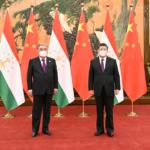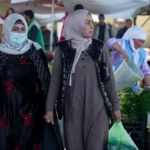The kids wear market is driven by growth in Sustainable and Ethical Fashion, rise in Gender-Neutral Clothing, and surge in focus of young consumers on comfort and functionality. Moreover, rapid technological advancement in the apparel and fashion industry has led to change in dynamics and made it easier for both customers and organizers to organize the market smoothly.
PORTLAND, Ore., Nov. 25, 2023 /PRNewswire/ — Allied Market Research published a report, titled “Kids Wear Market by Product Type (Apparel, Footwear and Accessories), End User (Boys and Girls), and Distribution Channel (Supermarket & Hypermarket, Online Stores, Specialty Stores, and Brand Outlets): Global Opportunity Analysis and Industry Forecast, 2023–2032 “. According to the report, the global kids wear market was valued at $194.1 billion in 2022, and is projected to reach $286.9 billion by 2032, growing at a CAGR of 4.1% from 2023 to 2032.
Prime determinants of growth
The growth of the kids wear industry is majorly driven by many factors. Market expansion for kids wear industry is significantly fueled by the fashion and apparel sector. Moreover, the kids wear market witnesed a shift toward gender-neutral or unisex clothing. Parents were challenging traditional gender norms and seeking clothing options that were versatile and inclusive.
Brands that offered a wide range of colors, styles, and designs suitable for all children, regardless of gender, were gaining popularity. In addition, comfortable and functional designs were gaining prominence in kids’ wear. Parents were looking for clothing that allowed their children to move freely and comfortably. Fabrics with stretch, adjustable features, and easy-care properties were becoming popular, aligning with the practical needs of parents.
The apparel segment to maintain its leadership status throughout the forecast period
Based on product type, the apparel segment held the highest market share in 2022, accounting for more than half of the kids wear market revenue and is estimated to maintain its leadership status throughout the forecast period. This category comprises outerwear such as coats and jackets, dresses for special occasions, tops such as shirts and sweaters, and bottoms such as skirts and trousers.
The demand for eco-friendly materials and ethical manufacturing practices has driven the popularity of sustainability and ethical fashion. The digital transformation has changed the market as e-commerce and online shopping continue to grow. Character licensing is still a thriving industry, and the availability of inclusive and gender-neutral clothing is expanding. The increase in popularity of fast fashion has satisfied the needs of parents who are looking for stylish yet reasonably priced items for their kids.
The boys segment to maintain its leadership status throughout the forecast period
Based on end user, the boys segment held the highest market share in 2022, accounting for more than half of the kids wear market revenue and is estimated to maintain its leadership status throughout the forecast period. Despite the growing awareness of sustainability and eco-friendly clothing options among environmentally conscious consumers, the trend of the leisure apparel which prioritizes comfort and adaptability, remains popular.
Character licensing continues to capture younger audiences, and a wider variety of clothing alternatives is made possible by the advent of gender-neutral fashions. Teenage boys are fond of streetwear and urban looks, such sneakers and graphic tees. Growth-promoting variables include the rise in discretionary spending, overseas expansion prospects, the significance of internet retail expansion, and the cyclical need for apparel.
The supermarket & hypermarket segment to maintain its leadership status throughout the forecast period
Based on distribution channel, the supermarket & hypermarket segment held the highest market share in 2022, accounting for more than two-fifths of the kids wear market revenue and is estimated to maintain its leadership status throughout the forecast period. Supermarkets and hypermarkets play a major role in the kids clothing sector because of the wide range of kids clothes they carry.
This entails carrying a wide range of kid-friendly clothing, supporting private label manufacturers that offer affordable yet high-quality options, supporting seasonal sales and sustainability, and enhancing their online presence to attract clients. Increasing client happiness and retention can be accomplished by introducing reward systems, providing personalized services and an enjoyable in-store environment, and promoting inclusivity and diversity in fashion choices. In addition, having licenses and relationships with well-known children’s clothing firms has provided designers of children’s clothing collections an advantage in producing distinctive and eye-catching styles. In this cutthroat industry, retailers have used data analytics to boost sales and gain a deeper understanding of consumer preferences.
The Asia-Pacific segment to maintain its leadership status throughout the forecast period
Based on region, the Asia-Pacific segment held the highest market share in 2022, accounting for more than two-fifths of the kids wear market revenue and is estimated to maintain its leadership status throughout the forecast period. When it comes to the kids clothing market, Asia-Pacific is the largest and one of the regions with the fastest growth rates. Growing disposable income has allowed families to invest more on fashionable, high-end children’s clothing.
The need for children’s clothes is directly driven by the area’s younger and expanding population, which presents opportunities for retailers and manufacturers. The rapid trend of urbanization has altered people’s lifestyle preferences and created a distinct market for children’s clothing with an urban motif. Growing brand awareness has led to a demand for branded children’s apparel, which has been facilitated by the influence of digital media and both domestic and foreign children’s clothing companies.
Leading Market Players:
- H&M Group
- Ralph Lauren Corporation
- Dolce & Gabbana S.r.l.
- Marks and Spencer plc
- Industria de Diseno Textil, S.A.
- Gap Inc.
- The Walt Disney Company
- The Children’s Place, Inc.
- Under Armour, Inc.
- Carter’s, Inc.
The report analyzes government regulations, policies, and patents to provide information on the current market trends and suggests future growth opportunities globally. Furthermore, the study highlights Porter’s five forces analysis to determine the factors affecting market growth.
Source: Cision PR Newswire
















